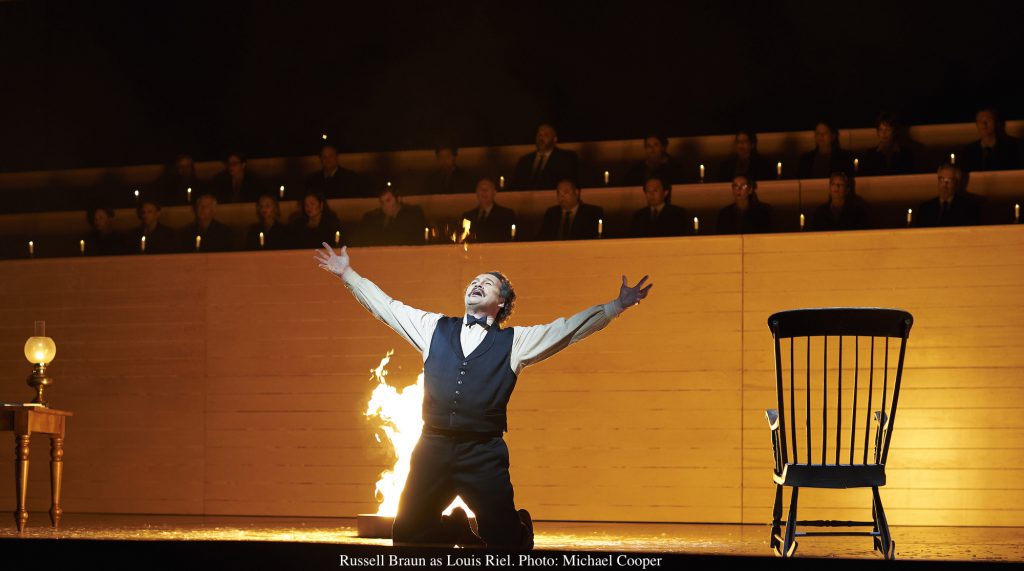Revolutionary, zealot, martyr — 132 years after his execution, Louis Riel is still a storied presence in the tangled narrative that is Canada’s past, an almost mythical character who lived outside his times. Born in St. Boniface, Catholic-educated, the former bookish Montreal seminarian aroused instant controversy the moment he first championed the sovereignty of fellow Métis in Manitoba’s Red River Settlement. His blunt, confrontational tactics panicked Anglo onlookers, Sir John A. Macdonald included. In March 1870, the increasingly volatile, ferociously devout frontier activist burst into the headlines.
Riel’s involvement in the politically motivated killing of Thomas Scott, a strident local Irish Protestant opponent of Métis self-rule, sparked a smouldering brush fire of broad anti-French, anti-Aboriginal sentiment in English Canada. By 1885 the hostility had become an inferno. Persuaded to flee exile in Montana, a re-energized Riel roused a force of Métis and Cree resisters, striking a desperate blow in defence of existing Native land grants along the South Saskatchewan River near the village of Batoche. Shotguns and old buffalo rifles were no match for the long range field artillery and Gatling gun of Ottawa’s hastily assembled paramilitary expedition. Riel surrendered. After a tense four-day show trial in Regina, the self-asserted Prophet of the New World was convicted of treason and hanged.
Many called Louis Riel insane, a shallow attempt to dismiss what would become his lasting legacy. The struggle of Indigenous peoples for equality and justice continues, mad ideals by 19th century colonial standards. Pressing goals in the quest for truth and reconciliation today.
In this, Canada’s sesquicentennial year, Louis Riel, the opera, first presented by the Canadian Opera Company in 1967, reasserts itself in a resourceful revision that, despite best intentions, speaks more of faltering artistic values than acquired insight. As guiding partner and co-producer, Ottawa’s National Arts Centre hosts the landmark production in mid June conferring broad cultural status on the shaky 20th century work. Sadly for eager audiences, no amount of stylish new staging or brave attempts at inclusiveness can redeem what is essentially an anachronism.
The threat of cultural appropriation casts a menacing shadow across Louis Riel’s horizon. Director Peter Hinton does his level best to add shape and texture to Mavor Moore’s starkly linear libretto, a 3-act collection of 17 discrete truncated sketches highlighting the historical record. Innate Aboriginal context, missing or minimized in the original, is duly evoked and reinforced.
Surtitles are framed in the native languages of the four principal nations populating the conflict — French, English, Michif and Cree. New characters are added — the Activist, speaker for those who once held their ancestral lands in trust; the Folksinger, preserver of Métis heritage; the Land Assembly, a Native chorus of suppressed voices, silent pawns in the hostile clash of self-serving Eastern politics. Other Indigenous figures are spotlit. Poundmaker, the legendary Cree chief, is given a direct connection to the narrative in the form of a speaking role. A frenzied buffalo dancer provides an air of religious ecstasy.
Scenic resonance aside, issues of sustained dramatic integrity continue to plague the COC’s turbulent pageant. However much the freshly renovated cast of players may animate Hinton’s vision, they contribute little overall complexity. Louis Riel is still glaringly Anglocentric in its depiction of its tortured protagonist. The real Riel, part mystic, part anti-hero, is made to seem unremittingly one-dimensional, a half-crazed trouble-maker tormented by visions, a fanatical firebrand. The intimate, human side of the man is fundamentally and infuriatingly unrevealed. It is only in the last minutes of the Métis leader’s stage existence during the clumsily written trial scene that the character, crushed and exhausted, begins to engage our sympathies. Wraparound emotion goes unfulfilled.
An odd undercurrent of satire provokes more exasperation. As if the figure of Sir John A. Macdonald were not comic enough given Mavor Moore’s patent one-liners, costume designer Gillian Gallow’s contribution of red plaid suit and pseudo clown shoes ups the beleaguered PM’s numerous appearances to the level of sheer buffoonery. The visual humour all too frequently works at cross purposes. Macdonald is far from consistently funny. Donald Smith, governor of the Hudson’s Bay Company, dressed in iconic striped wool, becomes a ludicrous stereotype. The Parliamentary Chorus, confined to bleachers, 35 clamouring voices strong, represents a decidedly overworked contemporary theatrical metaphor, as self-evident and clichéd as the choristers’ skinny black 21st century business attire.
Originated by Toronto composer Harry Somers, Louis Riel embodies all the non-representational atonality and dissonant orchestration demanded of 60s modernists. Musical lines are twisted and bent, harmony deconstructed, rhythm shattered. Backdrops of synthetic electronic sound contrast with a jagged, percussive foreground. Voices are often unaccompanied, musically opposed at times, invariably intense. The score, almost without exception, is raw, brutal, even ugly.
Conducting a potent contingent of over 60 musicians, resident COC music director Johannes Debus leads the Canadian Opera Company Orchestra with uncharacteristic disregard for dynamic balance and weight. Singers are all but obliterated during seemingly endless outbursts of overwrought brass. The approach is as discordant as it is mystifying.
Louis Riel has epic proportions with 40 distinct roles populated by singer actors drawn from a variety of ethnic backgrounds and musical traditions. All display great commitment. There are some solid performances here and some considerably less grounded.
Appearing in the title role of Louis Riel, baritone Russell Braun bravely battles Somers’ violent score, frequently, against all odds, emerging triumphant. Faced with a virtual landslide of constantly shifting melisma, Braun ends Act I literally on his knees as Riel flings open his heart to God. The moment is blistering in its surrender, primal and haunted.
James Westman is a devious Macdonald, amber-toned as single malt. Alain Coulombe is a resonant Bishop Taché, Ottawa’s shamefully exploited go-between. Allyson McHardy sings Louis Riel’s mother, Julie Riel, with great dignity and serenity. Michael Colvin roars and rampages as Thomas Scott. Jani Lauzon voices the Folksinger, quietly and worldly.
Opening Act III with a tender if somewhat emotionally withheld rendition of Kuyas (Long Ago), Simone Osborne as Louis Riel’s wife, Marguerite, delivers the opera’s only aria, a Nisga′a prayer repurposed by Somers, amid considerable latter day controversy, as a lullaby. The song deserves a far more uplifting, more authentically spiritual treatment.
Much more can and should be said about the bitter issues this troubled and troubling work raises. As flawed and disappointing as Louis Riel may be as opera, the work has a good deal to contribute to the continuing Canadian conversation.


